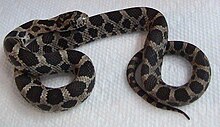P. gloydi
| Pantherophis gloydi | |
|---|---|
 |
|
| Juvenile | |
| Scientific classification | |
| Kingdom: | Animalia |
| Phylum: | Chordata |
| Class: | Reptilia |
| Order: | Squamata |
| Suborder: | Serpentes |
| Family: | Colubridae |
| Genus: | Pantherophis |
| Species: | P. gloydi |
| Binomial name | |
|
Pantherophis gloydi (Conant, 1940) |
|
| Synonyms | |
|
|
Pantherophis gloydi, commonly known as the eastern foxsnake or eastern fox snake, is a type of rat snake. It is nonvenomous and can be found in the eastern Great Lakes region of the United States, as well as western Ontario in Canada. It is sometimes considered a distinct species and sometimes considered a junior synonym of the species Pantherophis vulpinus.
The specific name, gloydi, is in honor of American herpetologist Howard K. Gloyd.
Between about 1990 and 2011, foxsnakes were sometimes divided into two species, with P. gloydi as the eastern foxsnake and P. vulpinus as the western foxsnake. A 2011 paper by Crother, White, Savage, Eckstut, Graham, Gardner proposed instead that the Mississippi River be established as the species boundary between two species of foxsnakes, and that those found to its east be considered P. vulpinus (including those previously known as P. gloydi ) and those found to its west be given the new name P. ramspotti.
P. gloydi is found in marshes and other wetlands, as well as in the adjacent fields and meadows. They are found in the eastern Great Lakes region. Both P. gloydi and P. vulpinus live in the state of Michigan. P. vulpinus lives in the Upper Peninsula, where it is sometimes known as the pine snake. P. gloydi lives in the Lower Peninsula of Michigan. They can also be found in Ohio in the United States, and in Western Ontario in Canada. Historically, P. gloydi populations were also in New York, but now are no longer found there.
...
Wikipedia

